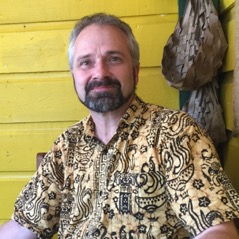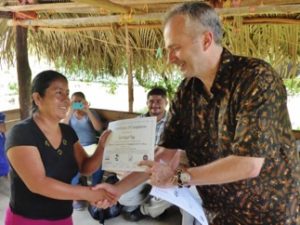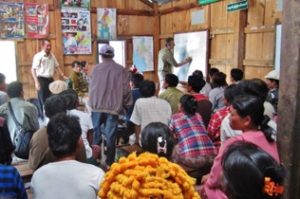
As part of the “Innovative finance for sustainable landscapes” interview series, the International Institute for Environment and Development’s (IIED) Forest Team Leader Duncan Macqueen spoke with Tropenbos International’s Nick Pasiecznik on increasing finance and investment in sustainable forestry and farming for smallholders.
“The challenge is to build strong producer organizations and change the perceptions of risk, return and transaction costs,” Macqueen said. This highlights direct support for strengthening membership, management and business as a strategy to develop bankable businesses with investment returns that are attractive to potential financiers. This will, in turn, improve livelihoods and provide an incentive for sustainable forest management.
Among Macqueen’s most recent publications is Access to finance for forest and farm producer organisations (FFPOs).
How do you define ‘inclusive finance’ and why is it important?
Inclusive finance ensures that local forest and farm producers are collectively involved in generating incomes, saving and making investments that improve their livelihoods. Importantly, it is not primarily about individuals, but about producer organizations that include women, landless people and ethnic minorities.
In developing countries, microfinance is rarely at a scale that can lift people out of poverty. Microfinance does, however, help to build individual capacities to understand and manage larger finance. To be transformative for forests and livelihoods, producers must be organized. Producer organizations are essential. They increase the economic scale and technological efficiency of transactions, and the credibility with which investments to upgrade transactions can be managed.
International finance rarely reaches forest and farm producers because financial institutions perceive the risk-to-return ratios and transaction costs to be too high. The challenge is to build strong producer organizations and change the perceptions of all involved.

What are the underlying reasons for the underfinancing of locally controlled agricultural and forest business?
Underfinancing comes down to a lack of a well-directed ‘enabling investment’, i.e. financial support that does not require a financial return. For small businesses to attract ‘asset investment’ which does require a financial return, enabling investments must secure tenure, develop technical production skills, enhance market access and business know-how, and strengthen producer organizations. Building up these four areas makes such businesses ‘bankable’.
There is also a finance gap between micro-finance and large-scale finance. Microfinance is often available. The sums are small, the periods short, the returns fairly predictable (with a high ratio of working-to-fixed capital), and interest rates can be raised to cover high transaction costs. But microfinance rarely stretches to mid-level investments allowing growth. Large-scale finance is also available, but commercial banks rarely address the small needs of producer organizations because of perceptions on returns, risks and costs.
Read more: Background note on FTA financial innovations for sustainable landscapes interviews
What are we not doing right, or not doing well enough, or not doing at all?
Producer organizations must be strengthened. This includes the leadership, management structure and staff skills required to manage savings transparently. Local producers need to organize safe ways of managing savings. Whether to invest in better technology or to repay loans for investment – saving is the key common need. Once saving patterns are established, producer organizations can build up capital, to invest, use as collateral, or to offer financial services for members.
Better forest business incubation is needed to build financial management capacities within organizations that are inclusive of marginal groups. This is already routine in business incubation, but many for-profit services struggle to cover costs in remote forest landscapes. Unless donors can subsidize such costs, their reach is unlikely to extend beyond urban centers. A more innovative solution is to develop business incubation services within umbrella (or ‘apex-level’) producer organizations to aggregate, process and market products and services from their members.
More financial de-risking is required for external investors. There are five immediate priorities: link producer groups with conventional finance through face-to-face meetings or social media technologies; form partnerships to develop loan appraisals for proposals to banks; find ways of developing collateral acceptable to banks (such as standing tree volume); offer guarantees based on social and environmental commitments to offset perceptions of risk; and help banks redesign financial products to meet producers’ capabilities.

How is your organization addressing inclusive finance, and what are your experiences and key lessons?
IIED is shaping more inclusive finance within its entire program. Its Natural Resources Group has helped FAO, IUCN and Agricord design a financing mechanism to support producer organizations through the Forest and Farm Facility (FFF). The first phase included 947 producer groups across 10 countries, with 262 businesses helped to add value or diversify products, and 158 examples of new access to finance.
Direct grants to producer organizations require gender equality and inclusion in membership, leadership and representation. Support includes market analysis and development training, learning exchanges, business fairs and trade shows, links to policy platforms, direct brokering of finance with value chain partners and banks, toolkits for risk management and forest business incubation.
FFF is also now reviewing how to improve access to finance and install forest business incubation capacity into apex-level organizations. We have learnt that direct support for strengthening membership, management and business is highly effective. Bankable businesses emerge with investment returns that are attractive to potential financiers, improving livelihoods and providing an incentive for sustainable forest management. This also creates a pipeline for investible businesses for financiers that will attract future investment. A focus on grants, concessional loans or patient equity for locally controlled forest cooperatives results in inclusive cooperatives, but a focus on debt finance for large corporates leads only to local people being treated as cheap labor.
Read also: Making landscape finance more inclusive
What examples do you have of successful or promising ‘model’ approaches or innovations?
Promising innovations come less from inclusive access to finance, but from inclusive distribution of finance. This is a question of business model design, often found in businesses with democratic decision-making where members who live with the consequences of their business decisions, balance economic, social and environmental trade-offs.
An IIED-led analysis of 50 case studies of democratic business models from 24 countries showed six clear innovations. Democratic oversight bodies governing environmental and cultural stewardship improve the natural environment. Negotiated benefit distribution and financial vigilance mechanisms improve material wealth. Networked links to markets and decision-making improve social connectedness. Processes for conflict resolution and justice improve peace and security. Processes of entrepreneurial training and empowerment for both men and women improve human capacity development. Branding that reinforces local visions of prosperity improves a sense of community purpose.
In Nicaragua for example, FFF-mediated finance for the Mayaring women’s cooperative led to the development of 15 new productss using ‘tuno’ (Castilla tunu) bark cloth for vegetables. This led to a 35 percent rise in household incomes and a forest landscape restoration project using the species.
What is your vision on how best to increase finance and investment in sustainable forestry and farming?
My vision is to tailor different financing approaches to different producer organization types. For example, finance could be directed to indigenous peoples’ organizations in natural forests for territorial delimitation and protection; community forest organizations at the forest edge for making sustainable forest management work in collectively controlled natural forests; forest and farm businesses in planted forest ‘mosaics’ for improved social organization alongside asset investments in production; and peri-urban and urban forest product-processing businesses to increase productivity. Financing could be primarily grant finance to indigenous peoples, grants and blended/concessional finance for community forest enterprises, a mix of leasing, trade chain finance and commercial debt finance and guarantees for producer organizations, and more conventional debt finance for peri-urban groups There is no simple rule – everything depends on the circumstances of the group.
Catalyzing multitiered organizations is part of this vision. This includes first-tier local producer organizations selling products and services; second-tier regional organizations aggregating products, adding value through processing, marketing and providing business incubation services to members; and third-tier national federations lobbying governments for more enabling policies. Evidence suggests that strengthening producer organizations is effective in poverty reduction, and improving governance, forest landscape restoration and delivery of the Sustainable Development Goals.
By Nick Pasiecznik, Tropenbos International.
This interview has also been published on the Tropenbos International website.
Duncan Macqueen is a principal researcher in IIED’s Natural Resources Group. IIED is a “policy and action research organization promoting sustainable development and linking local priorities to global challenges”. His research focuses on the success factors for locally controlled forest enterprises, and he has published widely on the subject. We invited Duncan to express his views on inclusive finance, based on his 25 years of experience of working with smallholder groups and communities to strengthen their capacities to run forest-based businesses and access markets and finance. He and his team have worked closely with FAO and the World Bank, among others. His publications include Prioritising Support for Locally Controlled Forest Enterprises and Financing forest-related enterprises: Lessons from the Forest Investment Program: IIED Briefing.
This article was produced by Tropenbos International and the Center for International Forestry Research (CIFOR) as part of the CGIAR Research Program on Forests, Trees and Agroforestry (FTA). FTA is the world’s largest research for development program to enhance the role of forests, trees and agroforestry in sustainable development and food security and to address climate change. CIFOR leads FTA in partnership with Bioversity International, CATIE, CIRAD, INBAR, ICRAF and TBI. FTA’s work is supported by the CGIAR Trust Fund.











